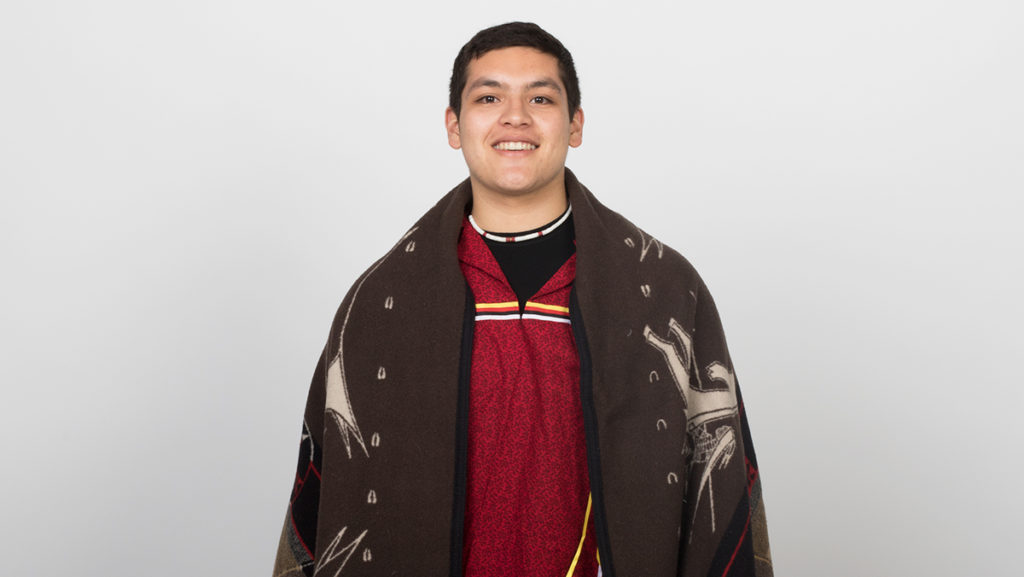December 4, 2014
The room is encased in a tense, heavy silence. A crowd of about a hundred students has gathered in the lobby of the Peggy Ryan Williams Center. Their chants of “No justice, no peace” and “Hands up, don’t shoot” that carried the crowd from the Campus Center to the administrative building have dissipated into the chilly December air.
Standing on the staircase, President Tom Rochon begins to address the crowd, a red-and-white bullhorn clutched in his hand.
In the crowd is Ithaca College sophomore Victor Anthony López-Carmen. He stands to the side, listening like the others to Rochon’s attempts to address systemic violence against black and brown bodies.
Senior Steven Kobby Lartey, who is standing next to Rochon, grabs the bullhorn from the president to call attention to the need for a structured Native American studies program on campus, complete with a tenured faculty member. The statement is met with cheers from the crowd, followed by impassioned chants of “Equality on this campus.”
“Thank you for the clarity of your voice — it couldn’t possibly be any clearer on that topic,” Rochon says. “And it will be taken from there.”
Victor takes a step forward and reaches his hand out to Rochon, gesturing for the bullhorn.
“I’m from the Yaqui tribe in Arizona,” he says into the bullhorn, facing Rochon. His voice quivers, trying to maintain a calm, steady tone. He stands at an average height — not quite small but not quite large — but his presence fills the room. It demands attention.
“And I don’t know if you know what it feels like to be one of at least 20 — not even 20 — identified Native Americans on this campus. We’re on Native American burial land right now, on top of graves of Native American souls of people. And we don’t even have a minor, not even represented academically, and this is an academic institution.”
His face is strained; he’s trying to be both composed and vulnerable. His words are met with choruses of snaps and loud hoots of support across the crowd.
“My great great grandpa was a chief of my tribe, and he died for me to be here.” His voice shakes, trembling with emotion and passion, but he raises it to nearly a shout as he stares directly at Rochon. “And I’m not here. My soul is not here because I’m not represented here.”
“We’ve never truly been defeated.”
It’s the height of another hot and dry Arizona summer in the mid-1990s. In the early morning hours, the pale dusk is tinged with almost-sunlight. A sacred run is about to begin. Groups of Native Americans, many from the Apache tribe which primarily organized the event, gather at a community center in Tucson. They’re ready.
A young Anthony Guy Lopez is also among the group of runners, preparing for the roughly 150-mile journey ahead. The destination: the top of Mount Graham, where construction for an observatory atop sacred Native lands is underway.
The runners take off under the heat of the sweltering sun, their feet pounding the desert ground beneath them.
The run is styled like a relay — one group of runners will cover half a mile to a few miles before passing a baton to the next group of runners. A van accompanies the runners along their journey, a place of respite during the runners’ breaks. During this particular run, Anthony’s son, Victor, is seated in the van, traveling with the runners until they reach their destination.
It’s only day one of the sacred run — several more days and about a hundred more miles lie before them.
Once they reach the camp at the top of the mountain — towering 10,719 feet over the Arizona landscape — they engage in ceremony and prayer, drinking water from the streams and praying in their Native languages.
“I was involved in all that growing up,” Victor said. “And it’s a huge part of our culture, and I still try to be involved in resistance today as much as I can.”
Resistance is in Victor’s blood — it pumps through his veins, drives his very being.
“We’re fighters,” he said. “We’re very militant.”
Victor is a an enrolled member of the Crow Creek Sioux Tribe in South Dakota and is also from the Pascua Yaqui Tribe in Arizona, two tribes that have continuously been resisting the tide of colonialism and fighting for their rights, their traditions and their sovereignty.
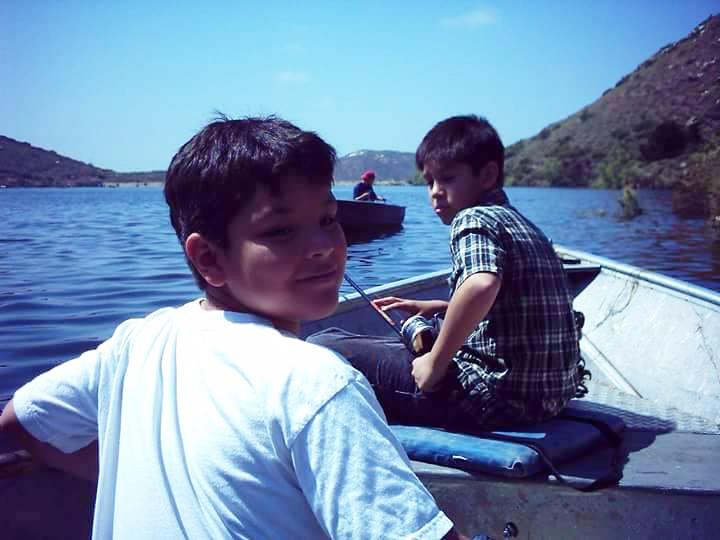
Courtesy of Victor A. López-Carmen
The Sioux people have been at the forefront of several notable battles between Native peoples and the U.S. government. 1876 was a pivotal year in the midst of U.S. expansion and entrenchment onto Native lands. U.S. military forces had devised a plan to force the Lakota and Cheyenne people to return to the Great Sioux Reservation. Lt. Col. George Armstrong Custer led the 7th cavalry, the bulk of this military force. To his surprise, he was met with a coalition of Lakota and Cheyenne fighters led by Sitting Bull, who overwhelmed Custer and his troops at the Battle of the Little Bighorn.
The Yaqui people, in particular, have consistently fought against colonial forces — and won. After having contact with non-Native people, a 400-year-long war ensued between the Yaqui and the Spaniards and later, the Mexican government. The Yaqui people survived in the end, preserving much of their sovereignty over the land and their culture.
We still have our lands,” Victor said. “And we’ve never truly been defeated — they’ve never been able to defeat us because we fight back.”
Victor was raised by a community of activists: his mother from the Yaqui people, his father from the Crow Creek Sioux Tribe and his aunt, Andrea Carmen Valencia, who is the executive director of the International Indian Treaty Council. Victor’s mother, Kathryn Carmen, works frequently with Yaqui traditional leaders. His father was an active participant in the American Indian Movement of the 1970s, a group that sought to bring together Native Americans under a renewal of spirituality and the need to draw awareness to the issues Native peoples faced because of the colonizing force of Europe and the United States. Oftentimes his parents would take Victor to these protests and demonstrations as a child, exposing him to a community of indigenous activism.
“We wanted him to have a connection to, to feel a connection to the Earth,” Anthony said. “To have kind of a deeper religious connection to the Earth, where he felt … he could feel the sacredness of life.”
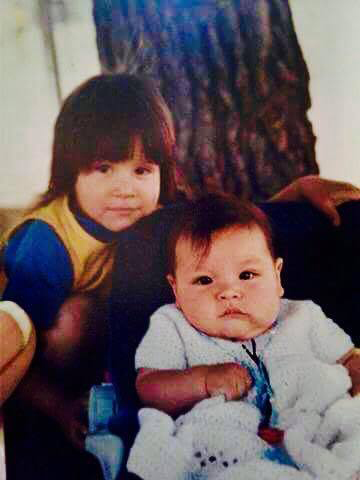
Courtesy of Victor A. López-Carmen
Taking Victor to sacred tribal ceremonies was another way to immerse him in Yaqui and Sioux culture. The Sun Dance from the Sioux tribe is one of the ceremonies that has stuck with him the most, ever since he began attending the dances at 6 years old.
The Sun Dance spans over the course of four days, involving participants heavily immersed in prayer as an act of reconciliation with God or to address another issue in their lives. The participants wake at sunrise every morning and dance until sunset with no food, water or basic comforts. Before being able to sleep, the participants enter a sweat lodge for four 15- to 30-minute sessions. In the middle of the room are sacred rocks that are lit on fire and a pit into which water is poured, thickening the air with heavy, hot moisture. Another important feature of Sioux culture, the sweat lodge is made to represent a mother’s womb: the heat, the dampness, the constriction, the water.
“It’s like a sauna multiplied by 50,” Victor recalled. “It’s so hot in there.”
The ceremony ends with a sense of rebirth — purification and reconciliation before the Creator.
“These are things that were most meaningful to me, that I participated in and witnessed,” Victor said.
Tradition, just like resistance, is in Victor’s heart. Being part of the seventh generation of Native Americans, he comes from a line of people who have been both resister and victim to the colonizer.
His grandmother on his father’s side, Roberta Maes, was forced to attend a boarding school run by the Episcopal Church in South Dakota: St. Mary’s Indian School for Girls. She and her sister spent two years at the school, away from their family and their Native culture. But they were not the only two forced into the boarding-school system, as their mother and father — Victor’s great-grandparents — were also forced to attend boarding school. There, they were forbidden from speaking their Native language, a policy that severed generations of Native Americans from their roots.
“After we all got older, my dad says he wished we would’ve kept our language because English is prominent now, so that’s kind of a hindrance, you know,” Roberta said. “To this day, we regret not speaking it, and you seldom hear an Indian nowadays speaking the language. It is sad.”
Victor moved around often growing up, living in one area for several years before packing up and moving to the next. For the first few years of his life, Victor lived in Alaska with his mother before returning to Tucson and living near Yaqui lands. In middle school, Victor moved to rural Virginia with his father — “We were, like, the only people of color there” — and stayed for a few years before moving back to Tucson once again. During his senior year of high school, Victor returned to Virginia to be with his father.
“It was hard,” Victor said. “One of the largest impacts that it had on me is that, being Native American, you want to stay close to your community. And moving around so much kind of — it had an effect where I felt more and more distance from my tribe in a way because I wasn’t near my family — I wasn’t able to go to the ceremonies.”
But this transitory state was inherited along with his activism, as Victor’s father also moved all over the country while growing up. With South Dakota as their home base, Anthony and his family traveled all over the United States, embodying what he calls a nomadic lifestyle.
“I think there’s something to be said about being able to live your life in a nomadic fashion,” Anthony said. “To be able to feel free in this country and not feeling bound to the reservation, to realize your identity.”
November 2016
Wednesday nights are salsa night, a highlight of Victor’s week. Every week at Agava Restaurant near Cornell University, he dances the salsa and the bachata to the sounds of Latin music pulsing through the air. It’s a respite, a way to let go and move more than think.
The room is always packed, but Victor moves as if there is no one else around him. He salsas effortlessly on the wooden dance floor, his feet light and quick as he front steps, back steps then side steps again in a single fluid motion. He does this all while meeting the beat of the music, his hips swaying side to side as he holds the hand of his partner. His arms twist into a pretzel-like shape as he spins his partner around, his feet continuing the same three-step salsa move.
But salsa night is only a few hours long.
Earlier that night, Victor was walking along the stretch of the Textor hallway, his quick footsteps barely audible on the tiled floor. The campus is blanketed in nighttime darkness, and the lights in Textor Hall are only dimly lit, leaving his body half in the shadows. He’s walking away from Textor 103, where he had just spent the last hour speaking to a room full of predominantly white students about the community of Standing Rock, North Dakota, and the protests against the Dakota Access Pipeline.
I wanted to tell them to leave the country and go back to Europe,” he says half-seriously. “Let us do our thing.”
He lets out a sardonic laugh as he continues walking, but the seriousness and exasperation in his voice remain. He’s tired.
The trees bookending each end of the benches outside the Campus Center are slowly losing their foliage, leaving them barren and brown in the early winter chill.
“It’s been difficult being 2,000 miles away.”
Victor stares into the distance through his black-framed glasses, his dark brown eyes looking at nothing in particular. He reflects on his transition from being surrounded by Yaqui and Sioux culture to attending a predominantly white institution: a place where Native Americans make up a minuscule percentage of the student population.
Victor missed a lot during his first years of college: his culture, his family, his language. There were no visits to the reservation or meals of traditional Native food, no participation in Yaqui or Crow Creek Sioux traditional ceremonies. To cope with the geographic and cultural separation, Victor tried to learn more about his culture and his native language.
“Whenever I hear a word or speak a word in either language, I just get this amazing feeling in my body where I get the chills, and it just feels good,” he said. “To say things in my native language, it’s like an act of decolonization.”
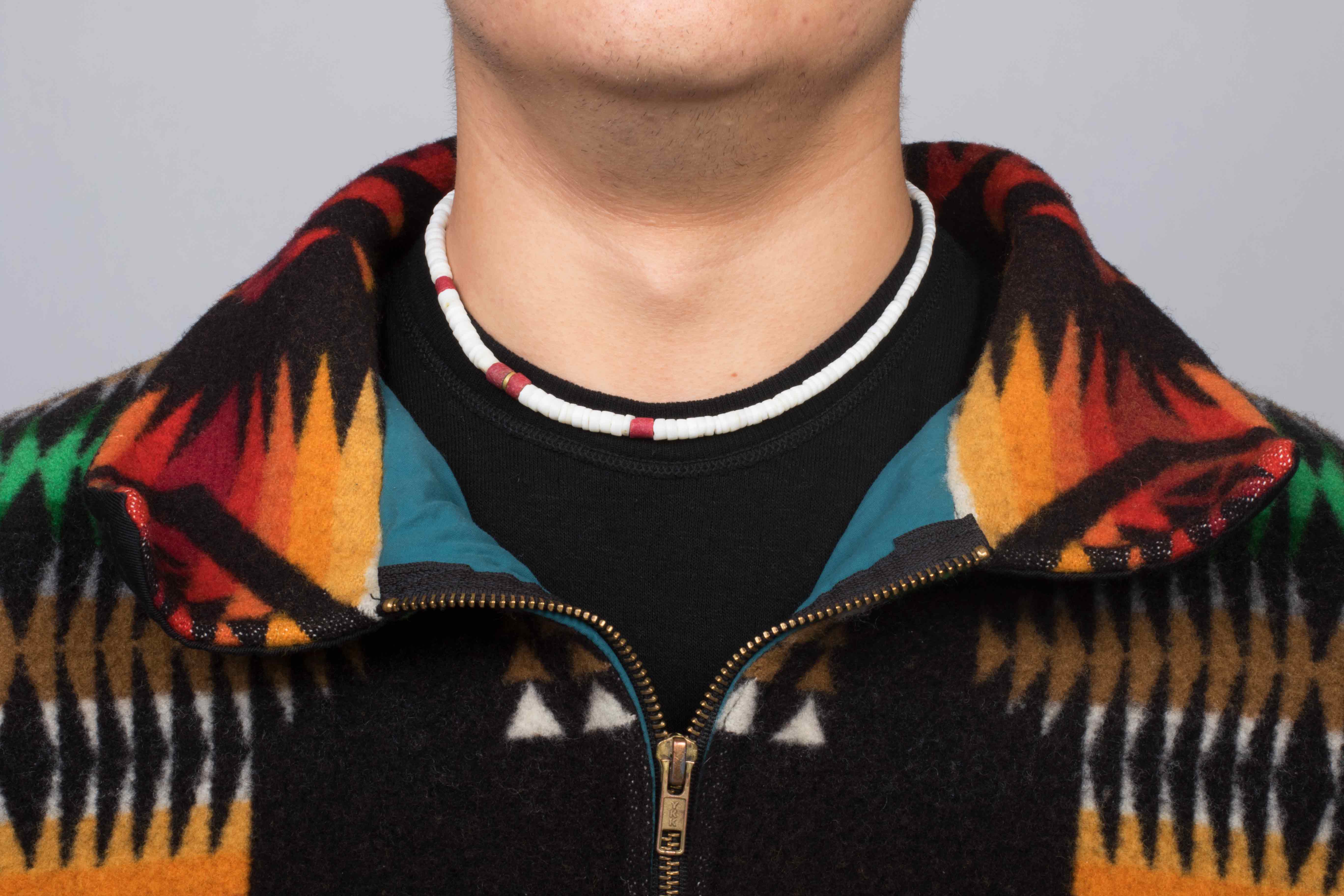
Being both away from home and older, Victor has searched for other ways to engage in the fight for indigenous rights. As a sophomore, he became involved with the United Nations’ Permanent Forum on Indigenous Issues, which brings together indigenous peoples from around the globe to advocate for indigenous rights.
As he talks, Victor is well-aware he is sitting on Native land, on grounds that once belonged to the Cayuga and Seneca nations before being taken by the U.S. government and sold to, among others, institutions of higher education.
Not everyone is aware that the grounds Ithaca College and Cornell University rest on once belonged to Native peoples. But there are always small discoveries that remind people in Ithaca of the history of the land they stand on. In September 2015, for instance, Cornell professor Kurt A. Jordan discovered that parts of Ithaca lie atop sacred burial grounds of Haudenosaunee Indians.
“I don’t really feel different … anywhere else I go because it’s the same all over the United States, so… yeah.” He chuckles more as he finds himself at a loss for words.
“I’ve kind of gotten used to it.”
His laugh fades into the air, and he takes a pause. Most of the quad is empty now, as students have scurried inside to escape the winter chill.
“Anywhere you go is violence, in a way,” he says, his voice taking on a steady, serious tone.
Everything in the U.S. empire was built off of violence, pretty much, and any building represents that and any institution. And so it’s a very difficult question, because I think, at this point, what indigenous people want is a way to coexist with the modern world in a way that allows us to continue our traditions, our culture. In a way that doesn’t impact the environment negatively. In a way where we are free and sovereign to do what we want with our lands.”
Victor’s gaze now shifts to the left, where the red-bricked enclave of the Free Speech Rock comes into full view: a place on campus Victor knows well. He’s stood on those steps before, with a crowd of students watching him as he watches them.
Victor has participated in many social movements since coming to the college, from the Collective in the Fall 2014, a group of students of color who organized around national and local racial issues, to the POC at IC movement a year later. And it was during his participation with the Collective that Victor began to push for a goal of his own: establishing a Native American studies minor at the college.
“I realized, you know, we’re on Cayuga and Seneca lands, and there’s really no homage or respect that’s given to that,” he said. “And so I thought maybe there should be some program where people can learn about that, learn about where they are and whose land they’re on and the history.”
Like most of what Victor does, advocating for the minor was another push for the recognition of the culture and dignity of Native Americans. To pull them out of the darkness even more.
In addition to Victor’s own ambition, being part of the Collective also helped place this issue at the forefront of administrators’ minds. Then came the protest Dec. 4, 2015. The Collective had planned a die-in and marched to the Peggy Ryan Williams Center to draw attention to the black men and women who died at the hands of police brutality.
The interaction between Victor and Rochon translated into action, as Rochon agreed to fund an active Native American studies program at the college.
“I was proud of the way Victor conducted himself,” said Tom Swensen, professor and chair of the Department of Exercise and Sports Sciences and mentor to Victor. “How is it that a 21-year-old student engages seasoned administrators in a positive fashion?”
Despite being far from home, Victor carries his culture and his tribal traditions with him anywhere he goes. It’s at the core of who he is.
Andrea helped Victor attend the U.N. Permanent Forum on Indigenous Issues. Victor has since participated in the program for the past three years, becoming yet another way he has stayed connected to his roots while being away from home.
As a health science major with a premed concentration, Victor keeps the health and welfare of his people at the center of his professional goals.
“I think he’s got a human rights lens,” Andrea said. “Even at his work as potentially a doctor or scientist … I think he wants to put it to use not just for his own self and own betterment but for humanity.”
Victor’s passion for indigenous rights and his loyalty to his tribe is as apparent now as it was to Swensen when he first met Victor.
Their first interaction came at the beginning of Victor’s freshman year within the first two weeks of the semester, when Swensen was teaching Victor’s anatomy and physiology class. Victor had taken the liberty of visiting Swensen’s office — just to talk. But it was an interaction that has stuck with Swensen ever since.
“We just talked for like two hours about everything,” Swensen said. “About his culture, Native American culture, just even more broadly about, you know, about biological things, natural selection, sexual selection.”
The two have had countless interactions since then, from dinners to hikes to playing chess to watching “Game of Thrones.” And through those interactions, many conversations would come back to Native American culture and Victor’s loyalty to his family and to his tribe.
“I think Victor helped educate me on what it is to be Native American,” Swensen said. “So he became my teacher.”
“Colonialism is the reason”
It’s late November, and Textor 103 is congested. Students are filling the long rows and spilling into the sides of the room. Almost everyone in the room is white. An
attentive silence fills the lecture hall. The students have spent the last half-hour listening to environmentalists and Native American activists talk about the Dakota Access Pipeline protests.
There is a call for one more question. All eyes look around the room, waiting. A white man on the far left of the room raises his hand.
He stands up, hesitating for a second:
“Is there anything that non-Native people can keep in mind if they were to try to go join the protest over winter break?”
Victor, who is one of the panelists of this teach-in, takes this one.
“I’d say yeah.”
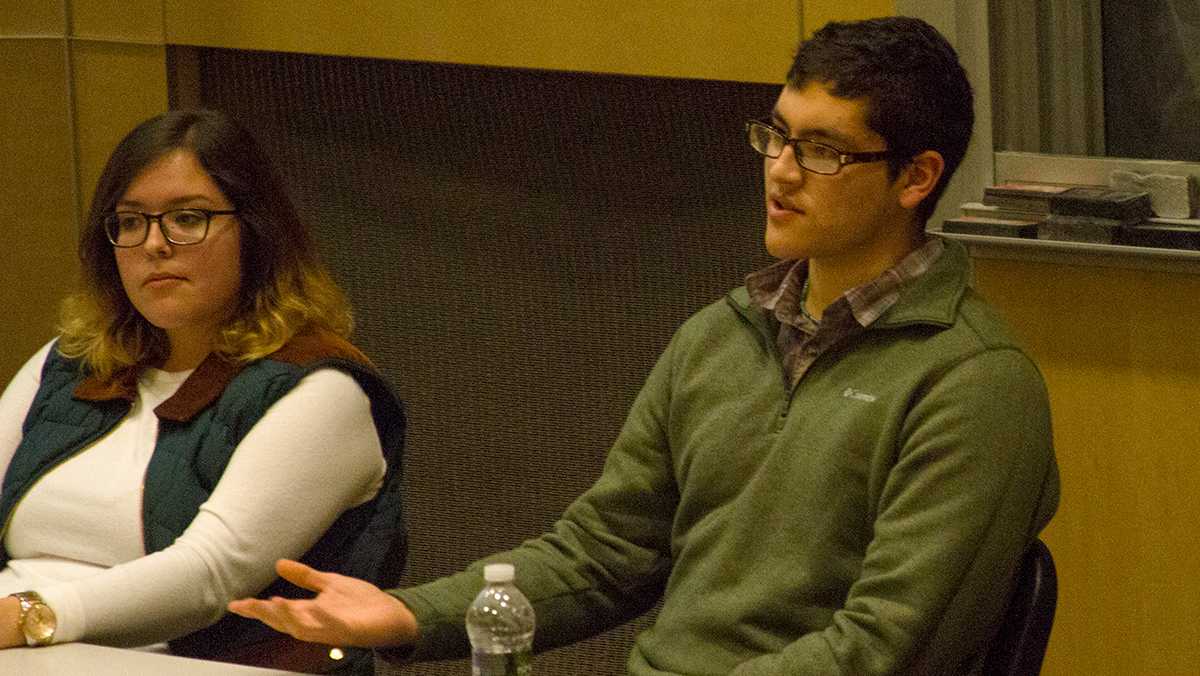
Progressives, about the conflict at the Dakota Access Pipeline.
Jade Cardichon/The Ithacan
He stops to think about what he could possibly say to this room full of white people. The pause is filled with a chorus of uncomfortable chuckles as students shift anxiously in their chairs.
“They like to focus almost entirely on the environmental side without recognizing colonialism, like you’re on Native American land that was taken away unjustly,” Victor says. He speaks slowly, deliberately. He’s crafting his answer in a way that will hopefully make sense to the sea of white people in front of him.
“Colonialism is the reason why the environmental degradation is occurring. In order to question the land, the colonialism, you have to also question your privilege living on this land. And people don’t want to question the legitimacy of the United States and the right to the land itself because that would put you at risk.”
Victor continues offering his advice to these white students, his eyes scanning the crowd before him, hoping they understand. That they get it.
The issue at Standing Rock began about a year ago, when plans to lay a monstrous black oil pipeline across 1,100 acres of land, from North Dakota to Illinois, sparked outcry from the Standing Rock Sioux Tribe, as the pipeline would slice through sacred Sioux lands. Since then, indigenous people from around the world, as well as climate activists, have flooded the Standing Rock land to protest the construction of the pipeline, representing the largest gathering of indigenous people in history. But despite a year of protests, the pipeline is still approved to cut through Native lands and pump oil beneath the river.
“I think what it comes down to for me is it’s our traditional land,” Victor said, referencing his close connections to the Crow Creek Sioux nation. “So we have a right to defend them by any means necessary.”
The Standing Rock conflict reflects centuries of colonial violence against Native Americans, resulting in the taking of their land, the erasure of their culture and even their deaths. Every time the United States wanted to take five steps forward — in the name of exploration or expansion — Native Americans were forced to take 10 steps back.
They just stepped on the Indian like they’ve always done,” Roberta said. “It’s just so unfair.”
“They don’t realize what the Indian gave up and sacrificed.”
Much of the media coverage around Standing Rock has centered the fight as an issue of environmentalism. And while the pipeline poses a danger of poisoning the Native people’s water supply and degrading the landscape, it is also a fight for indigenous sovereignty.
“A lot of people try to reappropriate it into an environmental problem when it’s really a colonist/colonizing problem,” he said. “And that kind of takes the blame away from some aspects of colonialism, you know, when people try to say this is mainly about the environment. No. It’s about you being on our land and not giving us the rights that we deserve.”
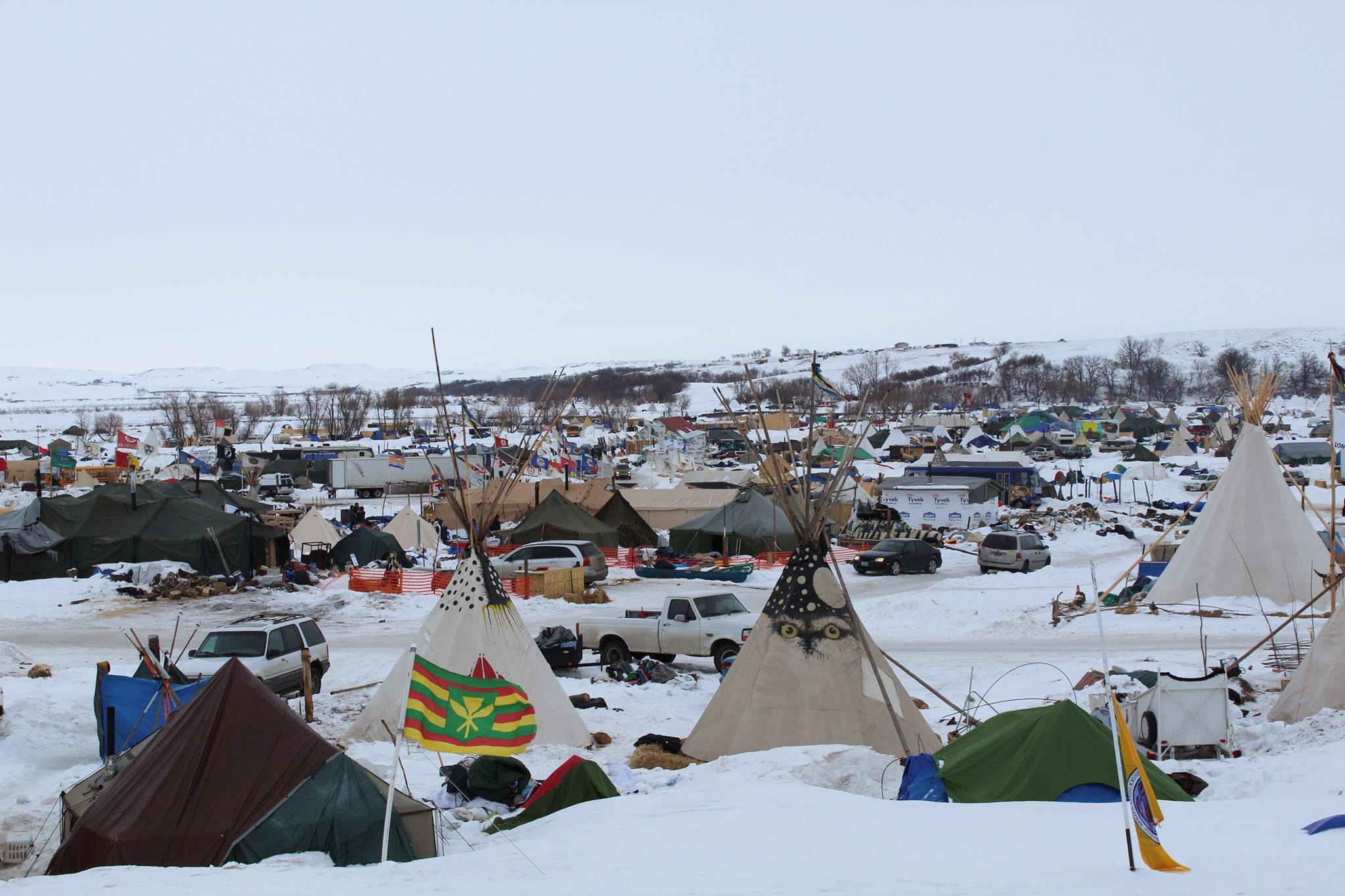
Support for the Standing Rock people against the Dakota Access Pipeline was primarily facilitated through social media. People frequently used the hashtag #NoDAPL, and millions “checked in” to the Standing Rock site on Facebook as a show of solidarity against the police. Though actions like these show that people care, Victor remains skeptical.
Everyone’s kind of finding the escape route because they don’t want to face that they’re invaders to the country,” Victor said. “That they’re still on indigenous lands that were stolen. That they’re benefiting from generations of genocide. That they’re beneficiaries of violence.”
When Victor says “they,” he’s referring primarily to white people. To their ignorance, their blindness. To what he characterizes as their inability to reconcile with their shared history of colonization.
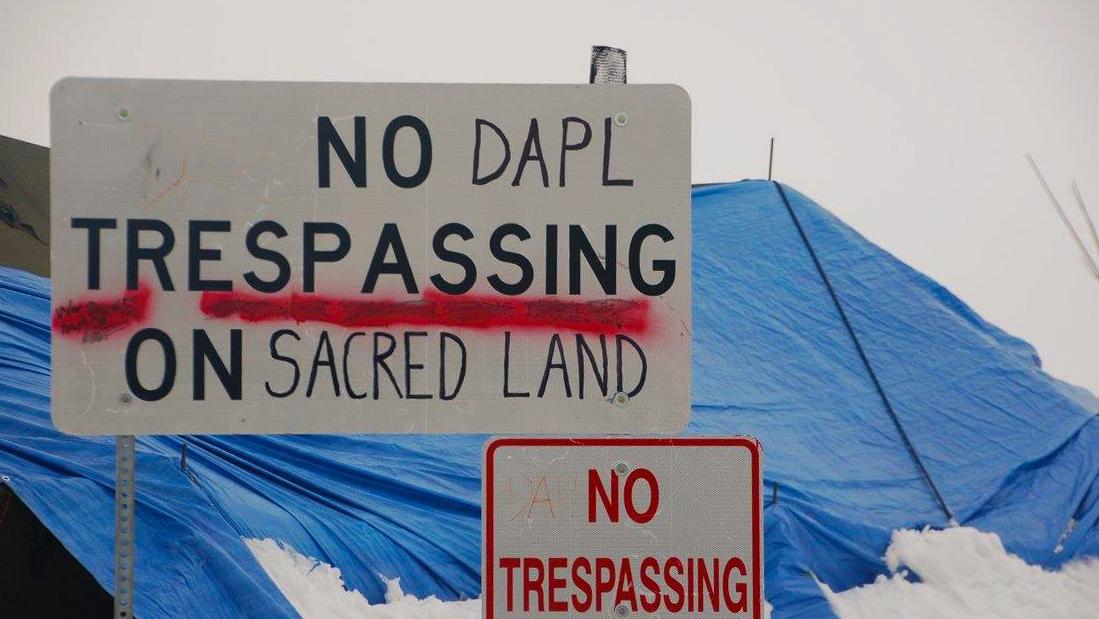
“I think the main thing is they need to respect the fact that they are accomplices in this colonization, first of all,” he said. “And they benefit from it. They live in a settler state which pretty much illegally took over and committed genocide.”
Coupled with this lack of awareness is a desire to participate in Native American culture — “They want to experience Native American culture,” Victor said in an exasperated tone — and many white activists have flooded Standing Rock grounds to fulfill this desire.
“The Indian language and their customs, all that,” Roberta said. “I see white people doing it now. … It’s so wrong, the way the land was taken to begin with and then to turn around and practice Indian ways. … It’s so sad.”
In the 16th century, indigenous people were met with disease and slaughter. In the 21st century, they are met with rubber bullets, tear gas, concussion grenades — a barrage of modern-age weaponry used against indigenous people and their allies at the Standing Rock camp. When Victor visited the Standing Rock camp from Jan. 20 to 27 with the International United Nations Treaty Council, he collected testimonies from many Native people recounting the violence waged against indigenous people.
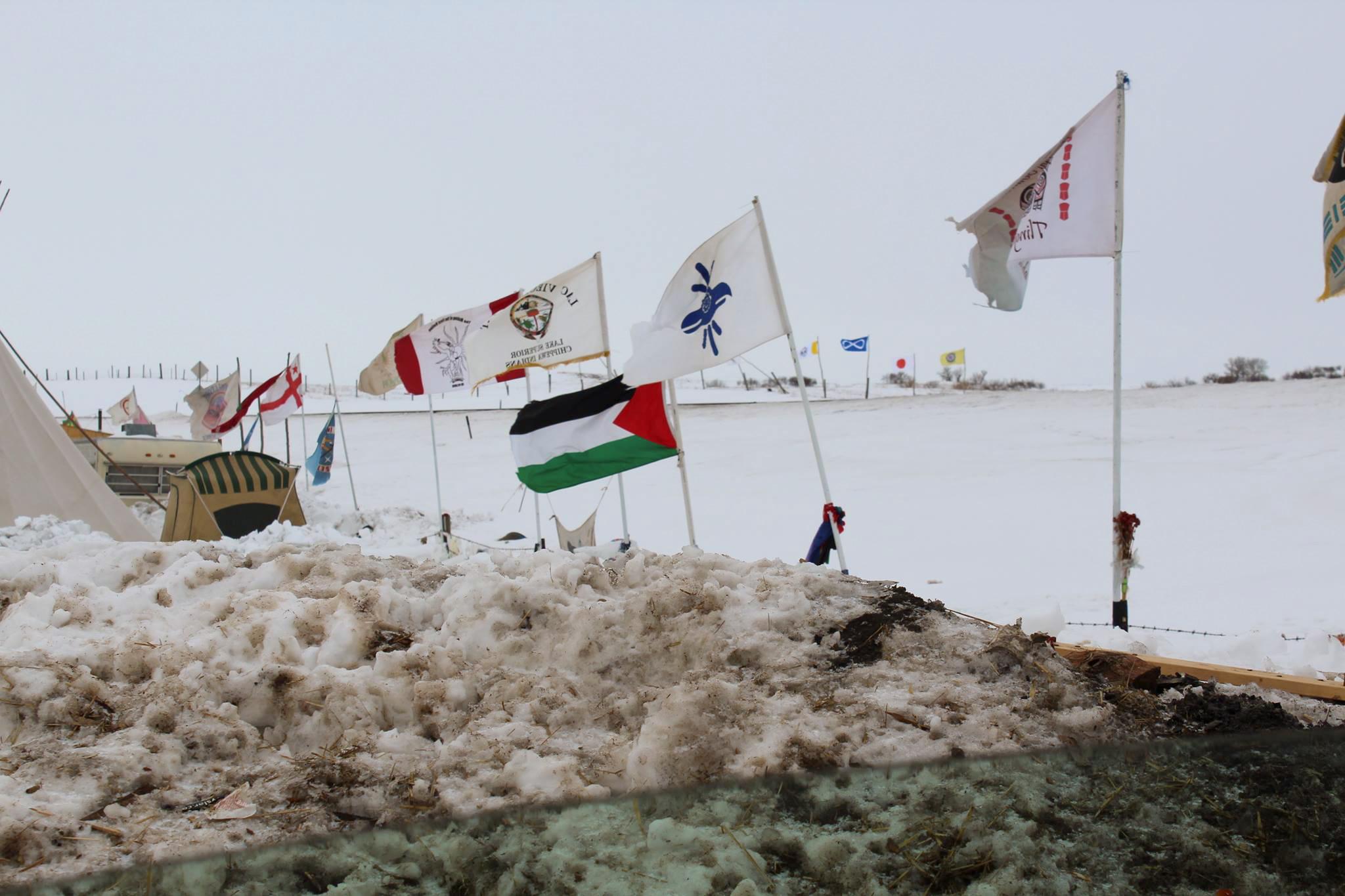
There was one man, probably around Victor’s age, praying peacefully at the front lines, his hands raised above his head. Police shot him with a rubber bullet, hitting him in the eye and blinding him.
There was a pregnant woman who, like the young man, was also praying at the front lines. Police threw a flash grenade into the crowd, and it exploded in front of her.
There were also the elders, the leaders of the tribe, who were being shot at by police. They, too, were praying when attacked by militant police. The elders were also thrown in jail and forced to strip naked.
“Everyone there needed so much help,” Victor said. “They were being sprayed with tear gas, and you could still see the blood on the snow from when they were shot.”
He and his team listened to many hours of testimony from members of the camp. Yet with each testimony also came a feeling of helplessness, as many people expected more aid from the U.N. than the U.N. had the capacity to give.
“A lot of people have this idea of the U.N. as you can send in peacekeepers, and everything will be OK,” Victor said. “But things take so much time, and there’s so much bureaucracy, and that was frustrating for them as well as us. ”
Even the taking of testimonies was confined, as many indigenous people were forced to strip their stories. All the U.N. wanted was the “who, what, when, where, why and how” of the story.
“It just seemed so against the way that indigenous peoples talk because it’s a European way of thinking where you put things in these simple boxes,” Victor said. “But indigenous peoples, our histories are oral, and so when we talk, we don’t talk so simply.”
Another issue at the heart of Standing Rock is the desecration of the sacredness of the water. “Mni wiconi.” Water is life. It’s a belief that is integral to both the Yaqui and Sioux cultures as well as to many indigenous people.
“Defending the purity of the water and the integrity of the water, it means you’re fighting for yourself, too,” Anthony said. “There’s something about Native people where we have this connection to the Earth that we’re not able to retreat from. So whatever befalls the Earth, you know, befalls us.”
The sacredness of the water reflects a reverence Native peoples have toward the land and for nature, whether it be the grass, the water or the flowers.
“We don’t enslave the land,” Victor said. “But we work together with it because God gave us the land. And we want to revere the Creator for giving us the land and thank him for doing that. And the best way you can do that is by having respect for what he gave you.”
Whether in Ithaca, at Standing Rock or elsewhere in the world, fighting for indigenous rights and continuing Native traditions will always be Victor’s rock.
“I think he’s continuing work that I did and other prior generations have done,” Anthony said. “He’s just carrying it on. He’s carrying on our legacy.”
He plans to do so this fall, having received a Fulbright award. The grant will take him to New South Wales, Australia, to study health in indigenous youth. It’s the first step in a long-term plan to use his education for the benefit of both his tribe and other indigenous peoples.
“He sees it as his cultural responsibility,” Swensen said.
April 2017
“Going to Standing Rock was…”
Victor’s voice trails off as he takes a long pause, lost in thought. He’s seated in IC Square, surrounded mainly by white people. He’s wearing a white shirt he wore at Standing Rock. It’s emblazoned with the phrase “Namakasia,” which represents the freedom of the Yaqui people and their dedication to continually fighting for it. Below the word are two cupped hands holding up a single water droplet that represents the Yaqui people and ensures their dignity, health and security.
The sounds of chattering students now become background noise. His eyes are concentrated as he struggles to finish his sentence.
“It was hard.”
Victor is surrounded almost entirely by white students in IC Square. It’s late April — three weeks before the end of classes and a month until Victor’s graduation.
The white students around him have no idea that the “they” he’s been using for the past half-hour — talking about their own complicity in colonialism — is them.
He thinks back to Textor 103 that November, to that room full of white students who were so desperate to learn. He wonders if they really understood the gravity of what he told them. If they really got it.
“I don’t know,” he says with a laugh that’s tinged with exasperation.
“Who knows?”
Victor A. López-Carmen is a columnist for The Ithacan.


